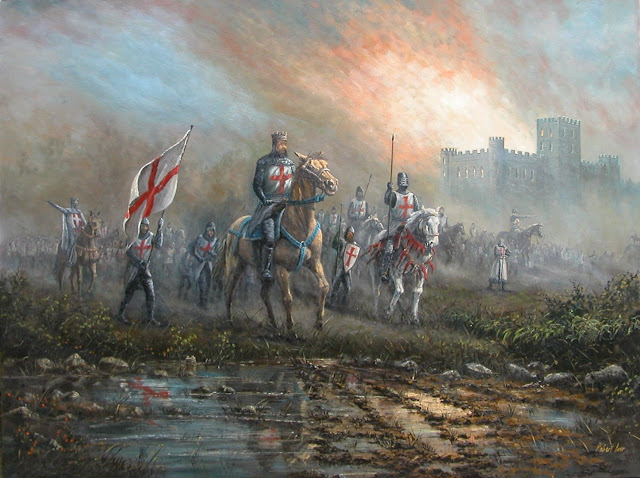|
As you probably know by now I have a bit of a thing about gasmasks, and of course you're well aware of my thing about dolls, so a doll in a gasmask? Well, seriously how can I resist?!
 |
Toxic Molly
|
I'd imagined it to be a weird dream, but then I discovered Toxic Molly... Sadly, by the time I knew she existed she was discontinued and hard as heck to get hold of unless you have a couple of hundred quid to spare, so the release of The Four Horseman of The Apocalypse series with War in his gasmask was of great interest to me and of course he ended up on my wishlist - Lucky for me Aaron, knowing my problem bought him for my Birthday too! 
Apart from the fact this doll comes with a gasmask, the other thing that drew me to him was his Surcoat and mantle which is based on The Knights Templar, The Order of Solomon's Temple.
While I am not so keen on the periods of history in which they were prominent - The Crusades, I have always had a keen interest in The Order themselves and the rise, decline, associations, legends, secrecy, legacy and connection with The Holy Grail of these fascinating "Holy knights".
I love that his outfit combines both modern and ancient combat garments which oddly don't look out of place on him. I also love that he comes with a little "
War Horse", like the others in this series, although his is red to match with the poem written on the front of his coffin shaped box.
The combination of garments used in War's uniform is no accidental grouping. In combining all these iconic uniform components it places War himself as spanning from the Human Race's first known combats right up to the present day - 21 Centuries of Warfare...
When you think of it in those terms it's revolting, especially when you consider we still haven't learnt.
War's uniform consists of :
Stahlhelm - Worn by the German Army during WW1 & WW2 (first introduced in 1916 and replaced in 1956), this style was also worn by Austrian, Hungarian, Ottoman, Chinese, Polish, British, Bolivian, Swiss, Argentine, Yugoslav, Chilean, Spanish, Irish troops wearing the same style or variations of it at during the same period, United States and El Salvador armies have also worn variations on this helmet design.
Gasmask - Gasmasks have been around in one form or another since their invention in the 9th Century. Originally invented to protect workers from workplace pollutants, they evolved over the centuries as needed. The gasmask in the form that we recognise today were invented in 1912 by Garrett Morgan as a smoke protecting safety hood. The design was patented in 1914 and that patent design was adapted for use as protection in WW1. This design was later modified again, with different Countries inventing their own versions, but the basis remains the same and is of course still in use for protection in warfare.
Surcoat - From around 12th Century knights wore a surcoat over their armour, this continued to be the case until the 15th Century when the surcoat became an armoured garment instead of a cloth one.
Mantle / Tunic - The Knights Templar wore a white mantle over their armour to deflect the heat of the sun, white was used to symbolise purity as they were crusading on behalf of The Catholic Church. To further illustrate that they have "taken the cross" they wore the symbol emblazoned on the front in red. This of course made them very recognisable and distinguished them from other knights in battle. This iconic garment was worn by the Templar Knights from 1129 until the order was disbanded in 1312.
 |
www.pinterest.com/dolls4emma/
|
Tunic Emblem - The Living Dead Dolls "War" wears a mantle which has bears the Cross of Lorraine on top of the symbol for eternity. These combined symbols create a unique symbol the origins of which are unclear.
It is said to be the Alchemic symbol for Sulphur (Brimstone) and also The Leviathan Cross which is often claimed as an invention of The Knights Templar.
The glyph was later used by Anton LaVey when it was placed above The Nine Satanic Statements in his book The Satanic Bible written in the 1969, as a consequence it has been linked to Satanism and is often referred to as "Crux Satanus" (Satan's Cross) although there is no other instance of this glyph being symbolic of Satan or Satanism outside of LaVey's usage!
The glyph has been used in recent years on the Living Dead Dolls' packaging and clothing, and also as a favicon and maker's mark on the official website since Ed Long and Damien Glonek released the first doll for public consumption 16 years ago!!
So it is only fitting that "War" should wear it as his emblem upon his mantle.
Chainmail - The earliest example of this protective clothing has been found dating from around the 4th Century BC. Chainmail is still worn as a protective layer in the 21st Century.
Cargo Trousers - First worn by British Armed Forces as Battle Dress in 1938, later by U.S Army in WW2, Australia, South Africa, India, New Zealand and Canada also adapted this style of trousers into their uniforms. Post WW2 Greece, Belgium, Norway, Argentina and The Netherlands also adopted this style. Variations of these trousers continue to be worn by Military throughout the World in the present day.
Combat Boots - First worn by Roman Soldiers during The Roman Empire ( 31 BC to 395/476 AD). A variation was worn by the New Model Army (1645 - 1660) during The English Civil War (1642 - 1651) In Switzerland combat boots were worn from 1779.
In The United States it was during the 1812 War that this type of boot became a staple of military clothing, up until 1820 when it was replaced with a ankle height style. This continued to be worn until 1858 until they were replaced with an improved style in the 1880s.
Combat Boots as we know them today, and as worn by "War" are worn by armies Worldwide as well as by various groups (Punk, Heavy Metal, Goth etc) as a fashion statement.
























































